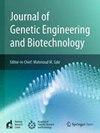Whole genome analysis of endophytic strain PM1 reveals promising plant Growth-Promoting mechanisms in pomegranate
IF 2.8
Q3 Biochemistry, Genetics and Molecular Biology
Journal of Genetic Engineering and Biotechnology
Pub Date : 2025-04-05
DOI:10.1016/j.jgeb.2025.100486
引用次数: 0
Abstract
The plant ecosystem harbours diverse symbiotic microorganisms with plant growth promoting and biocontrol activities. The gram- negative endophytic bacterium PM1 strain, isolated from the nodal region of pomegranate. The strain PM1 was studied through whole-genome sequencing, functional annotation, and plant growth-promoting trait (PGPT) gene analysis. Phylogenetic tree analysis and 16S rDNA sequencing confirmed its classification within the genus Brucella. The assembled genome size was 5,200,895 bp with a G + C content of 56.4 %. The average nucleotide identity (ANI) analysis revealed a 97.62 % similarity between PM1 and B. anthropi ATCC 49188 T, a type strain derived from human clinical samples, indicating a close relationship with Brucella anthropi. The functional annotation revealed 2,945 PGPT-related genes, including 32 % linked to direct effects (phytohormone signal production, biofertilization, and bioremediation processes) and 67 % to indirect effects (plant colonization, biocontrol, and competitive exclusion). KEGG analysis revealed genes involved in nitrogen metabolism, phosphate solubilization, siderophore production, hormone biosynthesis (gibberellin, cytokinin, and auxin), root colonization, and stress mitigation. Virulence factor database (VFDB) data revealed the absence of complete virulence gene assemblies, indicating limited pathogenic potential. Furthermore, secondary metabolite analysis predicted the potential production of ochrobactin compounds, which are potent siderophores that are important traits associated with PGPTs. The complete genome analysis of Brucella sp. PM1 provides new insights into plant-bacteria interactions, laying a foundation for advanced postgenomic studies and facilitating the development of bioeffective strategies such as biofertilizers or biocontrol agents for sustainable improvement in crop yields.

石榴内生菌株PM1的全基因组分析揭示了其促进植物生长的机制
植物生态系统中蕴藏着多种具有促进植物生长和生物防治活性的共生微生物。革兰氏阴性内生菌 PM1 菌株从石榴的结节区分离出来。通过全基因组测序、功能注释和植物生长促进性状(PGPT)基因分析,对菌株 PM1 进行了研究。系统发生树分析和 16S rDNA 测序证实了其在布鲁氏菌属中的分类。组装的基因组大小为 5,200,895 bp,G + C 含量为 56.4%。平均核苷酸同一性(ANI)分析表明,PM1 与人类临床样本中的一个类型菌株 B. anthropi ATCC 49188 T 之间的相似度为 97.62%,表明其与人类布鲁氏菌关系密切。功能注释发现了 2,945 个与 PGPT 相关的基因,其中 32% 与直接效应(植物激素信号产生、生物肥料和生物修复过程)有关,67% 与间接效应(植物定殖、生物控制和竞争性排斥)有关。KEGG 分析显示,基因涉及氮代谢、磷酸盐溶解、苷元生产、激素生物合成(赤霉素、细胞分裂素和辅酶)、根定殖和压力缓解。毒力因子数据库(VFDB)数据显示,缺乏完整的毒力基因组,这表明致病潜力有限。此外,次生代谢物分析预测可能会产生赭曲霉毒素化合物,这是一种强效的嗜苷酸,是与 PGPTs 相关的重要性状。布鲁氏菌 PM1 的完整基因组分析为植物与细菌之间的相互作用提供了新的见解,为先进的后基因组研究奠定了基础,并促进了生物肥料或生物控制剂等生物有效策略的开发,从而可持续地提高作物产量。
本文章由计算机程序翻译,如有差异,请以英文原文为准。
求助全文
约1分钟内获得全文
求助全文
来源期刊

Journal of Genetic Engineering and Biotechnology
Biochemistry, Genetics and Molecular Biology-Biotechnology
CiteScore
5.70
自引率
5.70%
发文量
159
审稿时长
16 weeks
期刊介绍:
Journal of genetic engineering and biotechnology is devoted to rapid publication of full-length research papers that leads to significant contribution in advancing knowledge in genetic engineering and biotechnology and provide novel perspectives in this research area. JGEB includes all major themes related to genetic engineering and recombinant DNA. The area of interest of JGEB includes but not restricted to: •Plant genetics •Animal genetics •Bacterial enzymes •Agricultural Biotechnology, •Biochemistry, •Biophysics, •Bioinformatics, •Environmental Biotechnology, •Industrial Biotechnology, •Microbial biotechnology, •Medical Biotechnology, •Bioenergy, Biosafety, •Biosecurity, •Bioethics, •GMOS, •Genomic, •Proteomic JGEB accepts
 求助内容:
求助内容: 应助结果提醒方式:
应助结果提醒方式:


